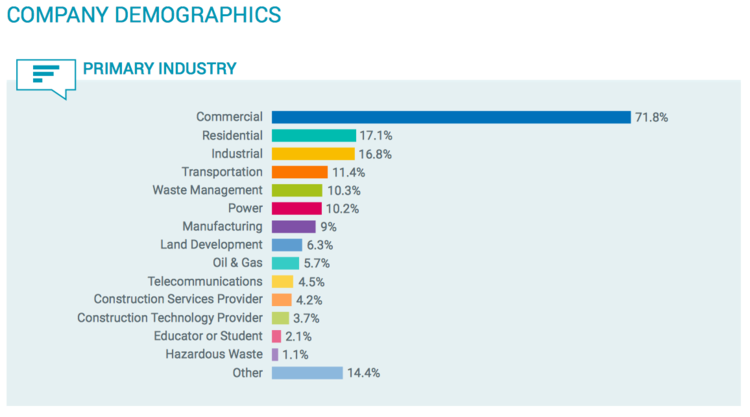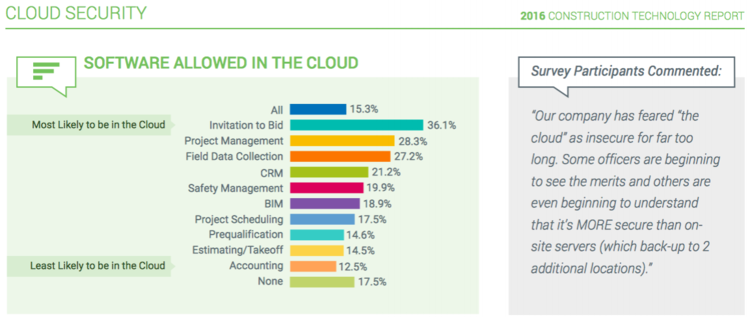 It’s finally here, and it appears to be worth the wait.
It’s finally here, and it appears to be worth the wait.
Arriving two months later than last year, JBKnowledge‘s 5th Annual Construction Technology Report is now available for download, rebranded ingeniously as an early Christmas gift for that AEC decision-maker on your list.
And there is something for everyone in this year’s survey, which is bigger and meatier than ever before, drawing on responses from a record 2,600 industry professionals. Produced in partnership with the Mechanical Contractors Association of America (MCAA), the Construction Financial Management Association (CFMA), and Texas A&M University’s Construction Science Department, the new study examines AEC software usage, integrations, cloud adoption, BIM/VDC workflows, mobile apps, data security, emerging tech, and the level of IT staffing and funding.
“While IT spending in construction remains lower than any other industry, this year’s report shows that 42.4% of companies are still finding a way to allocate budget for R&D,” notes JBKnowledge CEO James Benham, who also teaches at Texas A&M. “This is a promising statistic for institutions (that) dedicate staff and resources to furthering a culture of R&D in the industry.”
Among other findings:
- Mobile revolutionaries. Apps are now an accepted means for workflows. Since 2012, 20% more participants now rank mobility as “very important” when evaluating solutions to purchase;
- Subs love BIM. Thanks to MCAA members’ increased participation, the data shows a significant increase in BIM adoption, especially among mechanical, electrical, and plumbing trades;
- Cyber liability coverage is growing. The number of construction professionals who now have it more than doubled since last year, indicating that more firms are finally understanding the need for protecting sensitive cloud data, both for internal use as well as across shared project teams;
- Paper persists. Surprisingly, the number of those surveyed who are still using a manual process for invitations to bid grew yet again in 2016 to the highest level since the survey was launched.

“For years, MCAA has promoted the results of this survey as an independent analysis on industry trends in construction technology,” said Sean McGuire, MCAA’s director of construction technology. “As a sponsor this year, we were able to get powerful data to leverage for our members and within our research projects throughout the year.”
MCAA’s greater involvement this year accounted for a 9 percent increase in the subcontractor participation rate (see the above chart), noted Liz Welsh, editor-in-chief of the JBKnowledge report.

In light of this week’s revelations about the massive security breach of perhaps one billion Yahoo.com email accounts — not to mention the ongoing controversy over Russia’s attempted cyber-interference in last month’s U.S. national elections — the survey’s findings about data security assume even greater urgency. And they reveal much greater awareness now among construction professionals.

“Employee training continues to be the most frequent data security method used, most likely because it is the least expensive, and is often the ‘easiest’ to implement,” observed Welsh, who also noted the jump in cyber liability insurance expenditures between the 2014 and 2015 surveys. “These results show that more construction firms are understanding the need to implement cyber security defenses to protect sensitive data available in the cloud,” she added.

Still, even with this heightened awareness of core vulnerability — aka “the fear factor” — firms continue to struggle to justify IT expenditures as measured against return on investment (ROI). In fact, part of that problem, the survey finds, is that IT functions are still often lumped under finance departments. For that very reason, CFMA specifically aims to educate its members with this research. “For three years now, CFMA members have contributed to the increased growth and distribution of this report,” noted CFMA president & CEO Stuart Binstock. “It’s an important tool (for) construction industry financial managers who often serve as de facto CIOs, or who oversee the person who fills that job function.”
“I see a glimmer of hope in the increase of survey respondents with an R&D budget… What is the ROI of IT? The most innovative companies don’t necessarily have the biggest budgets, most experienced staff, nor the best solutions … ”
Added Benham, “This report helps us understand that the issue isn’t necessarily that builders don’t see the need for tech. It’s just hard to compute the return. Technology is an expense. It’s yet to be viewed as a value-add. … While this year’s report showed IT spending lower than ever, staffing still abysmal, and spreadsheets still rearing their ugly heads, I see a glimmer of hope in the increase of survey respondents with an R&D budget. … What is the ROI of IT? The most innovative companies in construction don’t necessarily have the biggest budgets, most experienced IT staff, nor the best solutions. They may be a five-person shop with just one technology champion who is making all the difference. Some companies look to outsource their champion, but it’s equally important to find a champion within your company, give them any tools (monetary or other) available, and task them with helping to identify and evaluate where technology can revitalize the company’s construction projects.”
For much more data and related insights, download the full report here.


Discussion
Be the first to leave a comment.
You must be a member of the BuiltWorlds community to join the discussion.